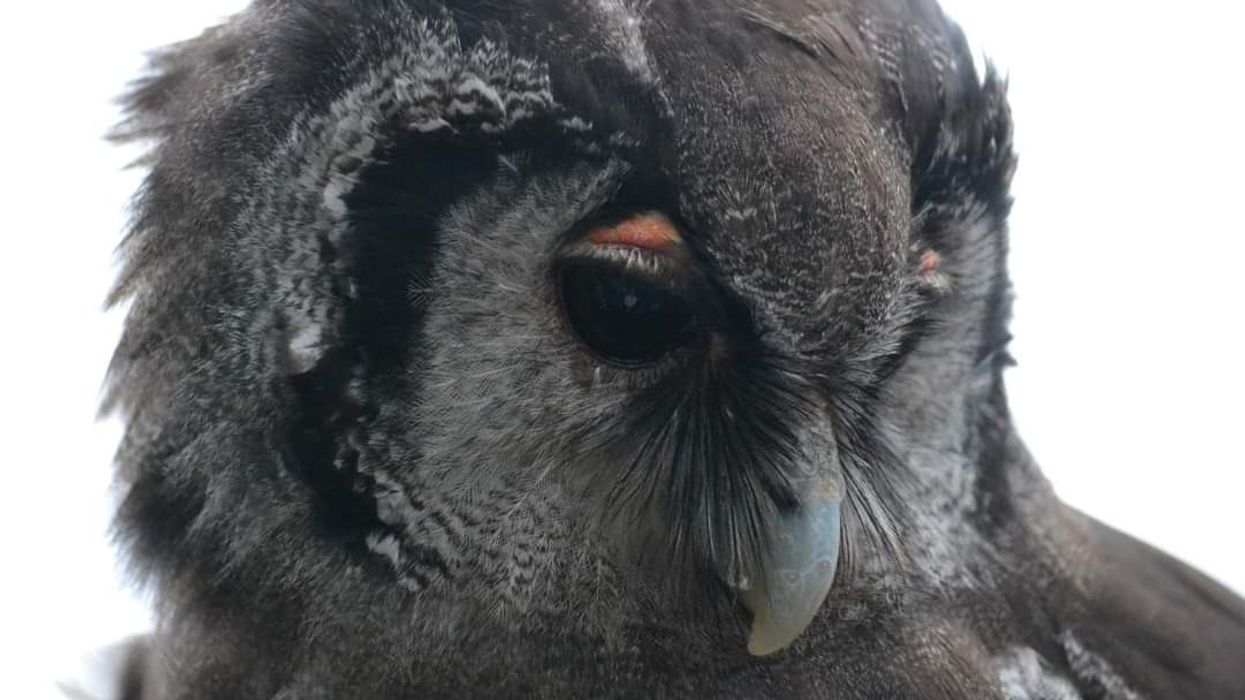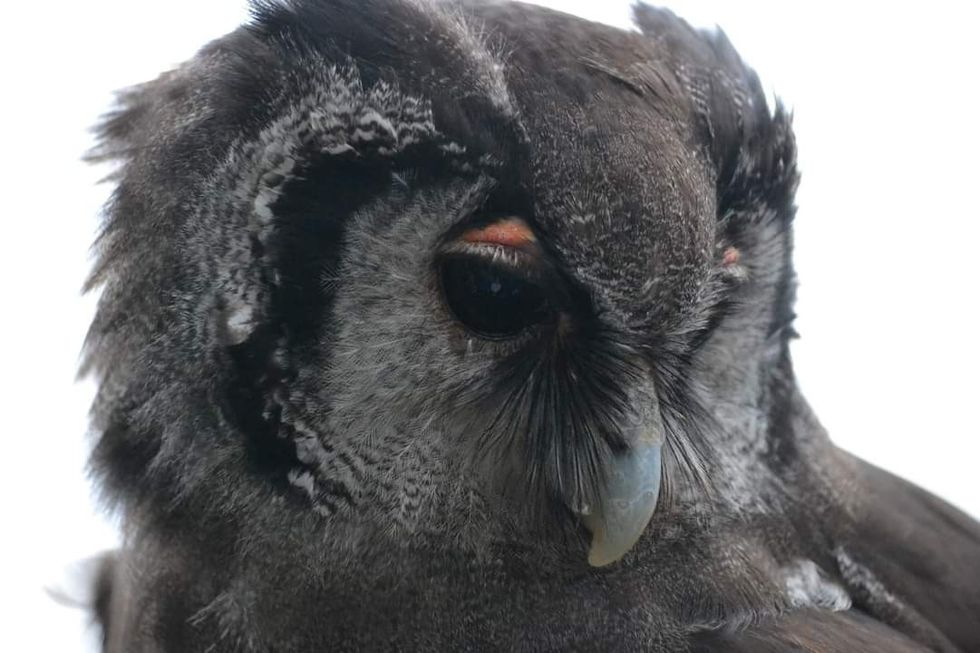The Verreaux's eagle-owl is the largest owl species in Africa. They are also known by the names giant eagle owl or milky eagle owl.
They have very powerful talons in comparison to other raptors that help them to prey. A large part of their food consists of small mammals but their diet also includes other similar-sized prey that. Numerous birds and even insects act as a food source for these eagle owls.
They are well distributed throughout their range and have a large nesting range in Africa. Their ability to adapt to several kinds of modified habitats stand beneficial for the species.
The largest populations are found in East Africa where they are seemingly common. However, in some parts of their range, the birds went missing due to overhunting.
They are also affected by the effects of pesticide poisoning. Habitat loss has reduced the range of suitable areas for the birds that nest in places with ample trees.
Destruction and degradation of trees in the African forests affected the bird's territory but their ability to adapt to human-modified lands and suburban areas kept their population stable. To know more about the eagle owl keep on reading these facts.
For similar content check out barking owl and Bengal eagle-owl facts too.
Verreaux's Eagle-Owl Interesting Facts
What type of animal is a Verreaux's eagle-owl?
The Verreaux's eagle-owl is a type of large owl that is found commonly in the sub-Saharan regions in Africa.
What class of animal does a Verreaux's eagle-owl belong to?
The Verreaux's eagle owl belongs to the class Aves, the common class for all birds.
How many Verreaux's eagle-owls are there in the world?
The global population of Verreaux's eagle-owls has not been determined. They are generally considered to be widespread around the world without any substantial threat to their population.
Therefore the population of these owls is believed to be stable throughout its range. The species is encountered commonly flying above large and abandoned fields in search of prey or for breeding purposes.
Where does a Verreaux's eagle-owl live?
The Verreaux's eagle-owl is distributed throughout sub-Saharan Africa. Most of owls populate the eastern and the southern African savanna. Their distribution is very rare in western parts.
However, in the eastern and southern zones, their distribution extends up to the borders of the rainforests. It is also less common in the Namibian desert.
Some isolated populations are found in Nigeria and Maali and extend up to the Central African Republic all the way south. They are also found in the Democratic Republic of Congo, Republic of Congo, northern parts of South Africa, and most parts of the areas of Namibia in south-western parts.
Further east of eagle owls inhabits Somalia, Sudan, Eritrea, and moves down to South Africa.
What is a Verreaux's eagle-owl's habitat?
The Verreaux's eagle owl prefers semi-arid regions and fails to survive in dry deserts. They are widespread in semi-arid to moist regions and tall woodlands.
The birds are generally found in large and open savanna consisting of thorny vegetation like cactus and scattered trees. They avoid nesting in primary forests and rainforests and instead they prefer living in riparian habitats consisting of well-developed trees.
They are encountered frequently in areas consisting of large size trees, open woodlands, and small forest patches. They remain perched on exposed branches of the tree during the day. Although they are nocturnal, hunting is also practiced during the day when they find prey nearby.
The roost in dense growths among large tree foliage during the day. The owls are found up to 9842 ft (3000 m) above sea level.
Who do Verreaux's eagle-owls live with?
Like other raptors, the Verreaux's eagle owls are also non-gregarious in nature. During the breeding season, they are found in pairs in their respective nests.
The nesting range of the birds is generally large mainly because the pairs select trees at great distances from each other. They do not breed in colonies. After the eggs hatch and the young ones emerge, the owl stays in small groups with its offspring.
How long does a Verreaux's eagle-owl live?
In captivity, the lifespan of a Verreaux's eagle-owl is observed to be around 15 years old.
How do they reproduce?
The breeding season of the Verreaux's eagle-owl lasts from March to September. They need a large territory for breeding and the pairs remain in close proximity to the nest during this time.
They often occupy the nest of other species like eagles, vultures, secretary birds, or hammerkops. The nesting arrangement includes tree hollows or cavities carved under the hollow-root trees on the ground. They line the nests with the remnants from their prey.
The female owl can lay up to two eggs in a single clutch. The laying season of the female last starts in June and lasts till August.
The eggs remain in the nests along with females. Females take the responsibility of incubating the eggs while the male brings food.
The eggs hatch after an incubation period of 38 days. The second eggs hatch after a week from the first one. Both the parents provide food for the first young chick but if the food sources are scarce, the parents do not rear the second young one.
In case of abundant food, both the young birds are reared by the parents. The young ones fledge the nest after they turn nine weeks old but remain in the parent's nest till three months old.
What is their conservation status?
According to the International Union for Conservation of Nature or the IUCN, the Verreaux's eagle-owl is enlisted as a Least Concern species in the Red List. They have a large extent in Africa, therefore, do not come under the threshold of vulnerable species.
Verreaux's Eagle-Owl Fun Facts
What do Verreaux's eagle-owls look like?
The Verreaux's eagle owls are large birds that are found in Africa. The ear tufts of the species are located on its head.
They have distinct grey-brown feathers on their ears with pale vermiculations. The owl is covered by a grey-brown plumage overall and they have light-colored vermiculations on its body. The face is light grey-brown in color than the rest of the body and therefore they are known as milky eagle owls.
The tails and the flight feathers are dark browns in color. They are barred by pale grey stripes. The strong legs are feathered helps them in hunting.
The owls also have distinct deep pink eyelids covering their brown eyes. Dark bars are present on the body of the young birds.
How cute are they?
The Verreaux's eagle-owl is a sharp-looking owl-like all raptors.
How do they communicate?
The eagle owl communicated by producing distinct calls. The Verreaux's eagle owl sound is a typical wok-wok-wok call.
How big is a Verreaux's eagle-owl?
The Verreaux's eagle owl size range between 26-28 in (66-71 cm). They are more than three-time smaller in length than the crowned eagles.
How fast can a Verreaux's eagle-owl fly?
The Verreaux's eagle owl flying speed has not been determined.
How much does a Verreaux's eagle-owl weigh?
The weight of a Verreaux's eagle-owl ranges between 3.6-7 lb (1615-3115 g).
What are the male and female names of the species?
A male and female eagle owl are known as a cock and hen respectively.
What would you call a baby Verreaux's eagle-owl?
A baby eagle owl is called a chick.
What do they eat?
The eagle owls are predators. The Verreaux's eagle owl diet includes a huge number of birds like crows, herons, and ducks as well as mammals like mongoose and rodents. They also prey on frogs and fish.
Are they poisonous?
No, they are not poisonous or dangerous.
Would they make a good pet?
No, they do not make good pets. It is a nocturnal bird in nature and can never adapt to the routine of humans.
Did you know...
The most common Verreaux's eagle owl predators are hedgehogs.
If you are wondering what it means to have an eagle owl Patronus, it means that the person finds comfort in solitude.
How did the Verreaux's eagle-owl get its name?
The name Verreaux commemorates the name of the founder of this species of eagle owl. This type of specimen was first spotted by the French naturalist Jules Verreaux. Verreaux collected this type of specimen when he was still a teenager and since then the bird has been named Verreaux's eagle owl.
What's the difference between a giant eagle-owl and a Verreaux's eagle-owl?
Even though the Verreaux's eagles owls are not the largest eagle owls in the world, they are known as giant eagle owls. These two names refer to the same species so there is practically no difference between the two. They are the largest owls that live in the tropics. For this reason, they are known as giant eagle owls.
Here at Kidadl, we have carefully created lots of interesting family-friendly animal facts for everyone to discover! For more relatable content, check out these Burrowing owl facts and Hawaiian hawk interesting facts pages.
You can even occupy yourself at home by coloring in one of our free printable owl coloring pages.
Main image by Steve Garvie









